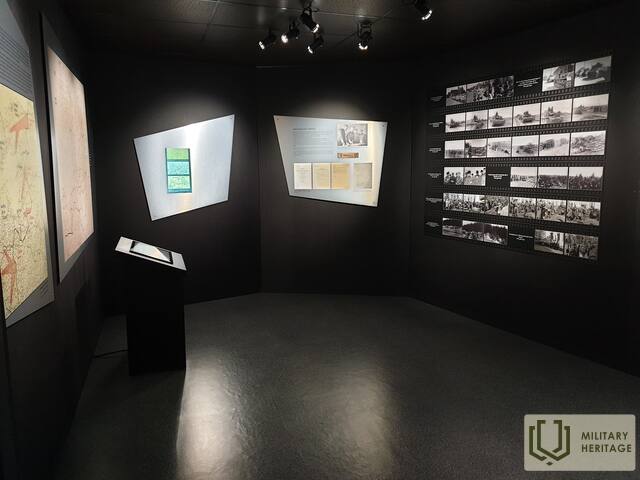Ezerės kraštotyros saugykla „Muitas Nams“ Muziejus

Ezerės muitinė yra Ezerėje, netoli Saldaus-Mažeikių plento, Latvijos ir Lietuvos pasienyje. 1945 m. gegužės 8 d. šiame pastate buvo pasirašytas vadinamojoje „Kuršo kišenėje“ apsuptų Vokietijos armijos dalinių „Kurzeme“ (Kurlandas) kapituliacijos aktas. Manoma, kad Antrasis pasaulinis karas iš tikrųjų baigėsi Ezerėje. Muitinėje yra ekspozicija, kurioje aprašomi Antrojo pasaulinio karo pabaigos įvykiai, ir eksponatai, kuriuose išsamiai aprašoma Ezerės parapijos istorija nuo seniausių laikų iki šių dienų. 1945 m. gegužės 7 d. rytą Leningrado fronto vadas maršalas L. Govorovas išsiuntė armijų grupės „Kurzeme“ vadovybei ultimatumą sudėti ginklus. Kapituliacijos aktą susijusios šalys pasirašė gegužės 8 d., jame išsamiai aprašyta perdavimo tvarka, ginklų surinkimo punktai, pateiktini dokumentai ir informacija bei kitos praktinės priemonės.
Panaudoti šaltiniai ir literatūra:
https://turisms.saldus.lv/kur-doties/ko-skatit/muzeji-un-kolekcijos/
Edukacinės programos
Ekskursija į Ezerės kultūros istorijos ir kraštotyros medžiagų saugyklą „Muitinė“
Ekskursijos metu lankytojai turi galimybę apžiūrėti modernią ir interaktyvią parodą „Karo veiksmų pabaiga Kuržemėje“ apie karo veiksmų pabaigą Latvijoje ir Kuržemės armijų grupės kapituliacijos akto pasirašymą Ezerėje. Taip pat pabrėžiamos karo pasekmės šiuolaikinėje visuomenėje, kur Antrojo pasaulinio karo įrodymai yra ne tik istorija, bet ir kasdienė realybė. Paroda yra daugiasluoksnė ir skirta tiek studentams, tiek besidomintiems. Be to, atsižvelgiant į užsienio lankytojus, turinys taip pat prieinamas anglų kalba. Siekiant pritraukti istorijos entuziastus, išsami parodos turinio dalis suteikia galimybę rasti konkrečios, išsamios informacijos apie kariaujančių šalių kariuomenės dalinius Kurše Antrojo pasaulinio karo pabaigoje. Archyvas taip pat suteikia galimybę susipažinti su Ezerės parapijos istorija, asmenybėmis ir įvykiais iš skirtingų laikotarpių.
Susijusi laiko juosta
Susijusi istorija
Edgaro Auninio, skridusio lėktuvu, prisiminimai apie Antrojo pasaulinio karo pabaigą Ezerės ežere
Ištrauka iš oro kapituliatoriaus Edgaro Aunino atsiminimų apie Kuržemės kapituliaciją 1945 m. gegužę
Atradimas Grieze filtracijos stovyklos vietoje
Grieze filtracijos stovyklos teritorijoje ir pakelėse, vedančiose į ją, dažnai randami įvairūs buvusiems kareiviams priklausę daiktai. Kareiviai, suimti civiliai, karo belaisviai ir kt. jais atsikratydavo dėl įvairių priežasčių – tiek norėdami išvengti identifikavimo, tiek norėdami išvengti „ypatingo dėmesio“.
Dingę vokiečių kareiviai Kuršo mūšyje - Karlas Grimmas
Vokiečių armijos grupės „Šiaurė“, vėliau pervadintos „Kurlandu“ per Kuršo apgultį, įrašuose vis dar nėra aiškios informacijos apie maždaug 50 000 vokiečių kareivių. Šie kareiviai yra įtraukti į dingusiųjų sąrašą. Net ir šiandien šių kareivių giminaičiai bando rasti savo giminaičių ir protėvių pėdsakų Kurše – tiek dokumentinių, tiek fizinių. Viena iš tokių istorijų – Karlo Grimmo, vokiečių kareivio iš Švabijos (istorinio regiono pietvakarių Vokietijoje, prie Reino ir Dunojaus upių ištakų), kurio karo karjera nutrūko 1944 m. spalio 27 d. Krūmų namuose netoli Vainodės (5 km į šiaurės vakarus nuo Vainodės, Latvijoje).
Kuršo mūšių metu dingę vokiečių armijos kareiviai - Hermanas Faulsas
Vokietijos armijų grupės „Šiaurė“, kuri vėliau, per Kuržemės apgultį, buvo pervadinta į „Kurlandą“, dokumentuose vis dar nėra aiškios informacijos apie maždaug 50 000 Vokietijos armijos kareivių. Šie kareiviai įtraukti į dingusių be žinios kovų metu sąrašą. Net ir šiandien šių kareivių giminaičiai bando Kuržemėje rasti savo giminaičių ir protėvių pėdsakų – tiek dokumentinių, tiek fizinių. Viena iš tokių istorijų yra apie Hermaną Faulą, kuris dingo nuo 1944 m. gruodžio 27 d. – 3-iojo Kuržemės mūšio, arba Kalėdų mūšių.
"Kasti geriau nei laidoti!"
Armijų grupės „Kurlandas“ įsakymas yra: „Statykite ir statykite!“ Tai užduotis kiekvienam užnugario fronto kareiviui. Tai geriausiai apibūdina žodis: „Geriau kasti, negu laidoti!“
„Karas nesibaigia, kol nepalaidotas paskutinis kareivis“ (Saldus vokiečių kareivių kapinės)
Kuržemė kaip atskiras ir savitas mūšio laukas iškilo 1944 m. spalio 10 d. Buvo suskaičiuota, kad apsuptyje buvo apie 500 000 vokiečių karių. Remiantis 1-ojo Baltijos fronto štabo pranešimais, norint visiškai išlaisvinti visą Baltijos pakrantę, reikėjo tik „nedidelių pastangų“. Tačiau kovos Kurše tęsėsi dar septynis mėnesius, ir Kurše tapo Antrojo pasaulinio karo pabaigos simboliu.
Per septynis kovos mėnesius iki 1945 m. gegužės mėn. vokiečių pajėgos Kurše neteko 154 108 žuvusių, sužeistų ir dingusių be žinios kareivių. Nuo 1997 m. netoli Saldus atliktas karo kapinių tyrimas ir perlaidojami kareiviai, o šiuo metu čia galima rasti 27 000 žuvusių kareivių vardų.
Pieta arba „Mamos“ memorialinis ansamblis Nīkrace
Pieta, arba Mamytė, yra gerai žinomas motyvas Europos kultūroje ir mene, jis buvo naudojamas ir sovietmečiu.
Peleninė su panteros galva iš vokiečių įtvirtinimų linijų
Krotės apylinkėse buvo įsikūrusios paskutinės armijų grupės „Kurzeme“ įtvirtinimų linijos, kuriose rasta daug su Antruoju pasauliniu karu susijusių objektų.
Jāņo Sūno prisiminimai apie laiką, praleistą Grieze filtravimo stovykloje
Advokatas Jānis Sūna savo autobiografinėje knygoje paskelbė prisiminimus apie laiką, praleistą Griezės filtracijos stovykloje.
Ezeroje kilusio Jānio Miesnieko prisiminimai apie Antrojo pasaulinio karo pabaigą Ezeroje
Ezerės kultūros istorijos ir kraštotyros muziejus „Muitinė“ įsikūręs istoriškai reikšmingame pastate. 1945 m. gegužės 8 d. čia buvo pasirašytas Kuržemės fronte apsuptų nacistinės Vokietijos armijos dalinių kapituliacijos aktas.
Buvęs Ezeras gyventojas Jānis Miesnieks (gim. 1930 m.) dalijasi prisiminimais apie tos dienos įvykius.
Kārlio Liberto prisiminimai apie vokiečių armijos kapituliacijos dieną Ezerėje
Ezerės kultūros istorijos ir kraštotyros medžiagų saugykla „Muitinė“ įsikūrusi istoriškai reikšmingame pastate. 1945 m. gegužės 8 d. čia buvo pasirašytas nacistinės Vokietijos armijos grupės „Kurlandas“, kuri buvo apsupta Kuržemės fronte, kapituliacijos aktas.
Buvęs Raudonosios armijos kareivis Kārlis Liberts dalijasi prisiminimais apie tos dienos įvykius.
Regiono tyrėjas Žanis Skudra nuteistas 10 metų kalėjimo už „Okupuotos Latvijos dienoraštį“
Žanis Skudra visą laisvalaikį skiria vietos istorijai, visas atostogas – kelionėms po Latviją. Taip jis kaupė medžiagą, fotografavo ir sukūrė „Okupuotos Latvijos dienų knygą“, kurią leidžia Latvijos nacionalinis fondas Stokholme, pasivadinęs Jāniu Dzintarsu.
1978 m. birželio 7 d. Žani Skudra buvo suimtas Taline, o tų pačių metų lapkritį Rygos Aukščiausiasis Teismas jam skyrė dvylikos metų laisvės atėmimo bausmę už išdavystę ir šnipinėjimą.












































